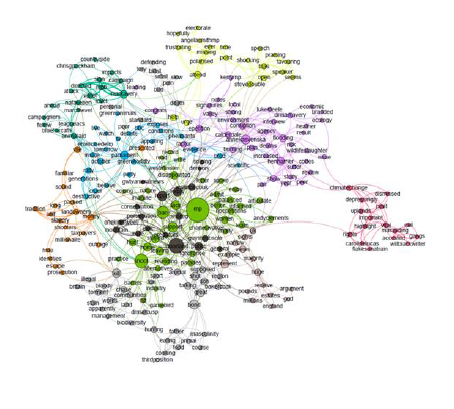Assessing the effectiveness of the e-petition procedure through Twitter conversations
Introduction
The House of Commons hopes that their new e-petition system, which was relaunched in July 2015, may help to provide a way to more effectively link people and parliament and to rebuild levels of trust in government. Crucially, it is hoped that signing a petition may act as a starting point for greater engagement. This study aimed to examine whether these goals are being met through the analysis of data from conversations held on Twitter focused on debates of successful petitions.
Data and methods
Tweets were collected from conversations around 21 parliamentary sessions between March and November 2016 using the Twitter Streaming API. One petition on 'banning driven grouse shooting' was used as a case study for in-depth analysis. Semantic network analysis was used to infer the topics being discussed in the Twitter conversations. A network was constructed with nodes representing words, and an edge between two nodes indicating that the two joining words had been found to co-occur. From this, clusters of words, and thus topics could be identified (Figure 1, below).
A sentiment analysis was also used to build an overview of the range of emotions expressed in the conversation. The interactions between the Twitter users taking part in the conversation were examined using social network analysis, based on retweet interactions. We were interested in who the influential users were and whether the network exhibited 'homophily', i.e. whether users preferentially interacted with other users who were similar to them.
Key findings
The number of people who engage in the Twitter conversation around a petition once it goes to debate varied massively; for some, there was a lively debate, and in regards to others, there was almost none.
No clear relationship was found between the amount of participation and the number of signatures the petition received. For the grouse shooting petition, an oral evidence session was held in addition to the debate, in which the petition creator and other experts were asked to give evidence. Comparison of reactions on Twitter between the two highlighted studies shows that there were significantly more negative emotions and thoughts expressed about the debate, in particular, there were suggestions of bias made. Suggesting e-petitions may be undermining trust in political institutions, something that they are meant to be re-establishing.

Figure 1.Semantic network for the Twitter conversation on the grouse shooting debate.
Within our case study, we observed how users interacted and found conversations to be composed of smaller sub-conversations, each controlled by an influential user being retweeted a lot. We also discovered evidence of homophily; people tended to have ties with people who are similar to themselves in socially significant ways. A Naive Bayes Classifier was used to code users as pro or anti grouse shooting, and it was found that users were much more likely to interact with another user from the same group.
Value of the research
This study demonstrates a method to carry out bulk analysis of Twitter conversations to quickly gain insight and overview. The study findings, that show members of the public may not be satisfied with the format of the debate process, are useful to the House of Commons Petitions Committee.
Researchers
Molly Asher, The University of Leeds
Cristina Leston-Bandeira, The University of Leeds
Viktoria Spaiser, The University of Leeds
